Seismic Response Analysis of Steel–Concrete Composite Frame Structures with URSP Connectors
Abstract
1. Introduction
2. Numerical Model and Validation
2.1. Finite Element Model
2.2. Validation by Pseudo-Static Frame Experiments
3. Seismic Elasto–Plastic Behavior Analysis
3.1. Basic Information of the Model
3.2. Model Analysis
3.3. Time History Analysis
4. Results, Analysis and Discussion
4.1. Roof Displacement
4.2. Inter-Story Displacement
4.3. Distribution and Failure Modes of Plastic Hinges
4.4. Discussion
5. Conclusions
- (1)
- The results of the horizontal seismic elasto–plastic time history analysis revealed that the full-span arrangement of URSP connectors under ultimate conditions had little effect on the first few natural vibration periods of the composite frame structure. However, it had different effects on seismic performance under different seismic loads. Compared with the results of the traditional stud connection, the calculated values of roof lateral displacement and inter-story drift angle were slightly larger in most cases. Specifically, this arrangement increased the maximum inter-story displacement by 31.5% and induced adverse effects in certain cases. In addition, the slight differences observed in the positions of plastic hinges, failure mechanism, and degree of plasticity development of the structure may result in adverse effects on earthquake resistance. In practical engineering, it is not recommended to adopt a full-span arrangement of URSP connectors.
- (2)
- In comparison with the traditional stud connection arrangement, the arrangement of half-span URSP connectors had little influence on the seismic performance of the composite frame structure, which still showed the good seismic performance of the original composite structure. The composite frame with a half-span arrangement can still be designed according to the relevant specifications of the traditional connection composite frame.
- (3)
- When URSP connectors are partially arranged, one should still consider the effect of the spatial composite effect of the floor on the composite frame under seismic actions, which is the same as that of a traditional stud connection composite frame.
Author Contributions
Funding
Conflicts of Interest
References
- Bursi, O.S.; Sun, F.F.; Postal, S. Non-linear analysis of steel–concrete composite frames with full and partial shear connection subjected to seismic loads. J. Constr. Steel Res. 2005, 61, 67–92. [Google Scholar] [CrossRef]
- Kim, S.H.; Kim, K.S.; Lee, D.H.; Park, J.S.; Han, O. Analysis of the shear behavior of stubby Y-type perfobond rib shear connectors for a composite frame structure. Materials 2017, 10, 1340. [Google Scholar] [CrossRef] [PubMed]
- Nakashima, M.; Matsumiya, T.; Suita, K.; Zhou, F. Full-scale test of composite frame under large cyclic loading. J. Struct. Eng. 2007, 133, 297–304. [Google Scholar] [CrossRef]
- Zhou, X.; Li, G. A macro-element based practical model for seismic analysis of steel–concrete composite high-rise buildings. Eng. Struct. 2013, 49, 91–103. [Google Scholar] [CrossRef]
- Braconi, A.; Bursi, O.S.; Fabbrocino, G.; Salvatore, W.; Taucer, F.; Tremblay, R. Seismic performance of a 3D full-scale high-ductile steel–concrete composite moment-resisting frame-Part II: Test results and analytical validation. Earthq. Eng. Struct. D 2008, 37, 1635–1655. [Google Scholar] [CrossRef]
- Hirst, M.; Yeo, M.F. The analysis of composite beams using standard finite element programs. Comput. Struct. 1980, 11, 233–237. [Google Scholar] [CrossRef]
- Nie, J.G.; Yuan, H.; Yi, W.J.; Fan, J.S. Seismic behavior of CFRSTC composite frames considering slab effects. J. Constr. Steel Res. 2012, 68, 165–175. [Google Scholar]
- Salari, M.R.; Spacone, E. Analysis of steel-concrete composite frames with bond-slip. J. Struct. Eng. 2001, 127, 1243–1250. [Google Scholar] [CrossRef]
- Pi, Y.L.; Bradford, M.A.; Asce, M. Second order nonlinear inelastic analysis of composite steel-concrete members. I: Theory. J. Struct. Eng. 2006, 132, 751–761. [Google Scholar] [CrossRef]
- Zhou, F.; Mosalam, K.M.; Nakashima, M. Finite-element analysis of a composite frame under large lateral cyclic loading. J. Struct. Eng. 2007, 133, 1018–1026. [Google Scholar] [CrossRef]
- Nie, J.G.; Li, S.P.; Chen, G.; Zhou, J.J. Finite element analysis on space action of steel frame structures with composite steel-concrete floors. In Proceedings of the Eighth Annual Meeting of China Steel Construction Society Steel-Concrete Composite Structure Association, Heilongjiang, China, 1 August 2001. (In Chinese). [Google Scholar]
- Jisr, H.E.; Kohrangi, M.; Lignos, D.G. Proposed nonlinear macro-model for seismic risk assessment of composite-steel moment resisting frames. Earthq. Eng. Struc. 2022, 51, 1180–1200. [Google Scholar] [CrossRef]
- Jisr, H.E.; Elkady, A.; Lignos, D.G. Hysteretic Behavior of moment-resisting frames considering slab restraint and framing action. J. Struct. Eng. 2020, 146, 04020145. [Google Scholar] [CrossRef]
- Tondini, N.; Zanon, G.; Pucinotti, R.; Di Filippo, R.; Bursi, O.S. Seismic performance and fragility functions of a 3D steel-concrete composite structure made of high-strength steel. Eng. Struct. 2018, 174, 373–383. [Google Scholar] [CrossRef]
- Linde, S.A.; Konstantinidis, D.; Tait, M.J. Rocking Response of unanchored building contents considering horizontal and vertical excitation. J. Struct. Eng. 2020, 146, 04020175. [Google Scholar] [CrossRef]
- Ramhormozian, S.; Clifton, G.C.; Latour, M.; MacRae, G.A. Proposed simplified approach for the seismic analysis of multi-storey moment resisting framed buildings incorporating friction sliders. Buildings 2019, 9, 130. [Google Scholar] [CrossRef]
- Liew, J.Y.R.; Chen, H.; Shanmugam, N.E. Inelastic analysis of steel frames with composite beams. J. Struct. Eng. 2001, 127, 194–202. [Google Scholar] [CrossRef]
- Chiorean, C. A computer method for nonlinear inelastic analysis of 3D composite steel–concrete frame structures. Eng. Struct. 2013, 57, 125–152. [Google Scholar] [CrossRef]
- Nie, J.G.; Tao, M.X. Slab spatial composite effect in composite frame systems. I: Effective width for ultimate loading capacity. Eng. Struct. 2012, 38, 171–184. [Google Scholar] [CrossRef]
- Nie, J.G.; Tao, M.X. Slab spatial composite effect in composite frame systems. II: Equivalent stiffness and verifications. Eng. Struct. 2012, 38, 185–199. [Google Scholar] [CrossRef]
- Wang, X.Q.; Xu, L.Y.; Tao, M.X. Influence of slab spatial composite effect on dynamic behaviour of composite frame structures under earthquake excitation. Bull. Earthq. Eng. 2019, 17, 3071–3094. [Google Scholar] [CrossRef]
- MSC. Software Corp. MSC. Marc User’s Manual; MSC Software Corporation: Santa Ana, CA, USA, 2007. [Google Scholar]
- Tao, M.X.; Nie, J.G. Fiber beam-column model considering slab spatial composite effect for nonlinear analysis of composite frame systems. J. Struct. Eng. 2014, 140, 04013039. [Google Scholar] [CrossRef]
- Lin, Y.J.; Zhang, X.Z. The slab effect of composite frames: From modified fiber modeling to seismic fragility assessment. J. Constr. Steel Res. 2021, 186, 106877. [Google Scholar] [CrossRef]
- Zona, A.; Barbato, M.; Conte, J.P. Nonlinear seismic response analysis of steel–concrete composite frames. J. Struct. Eng. 2008, 134, 986–997. [Google Scholar] [CrossRef]
- Vasdravellis, G.; Valente, M.; Castiglioni, C.A. Dynamic response of composite frames with different shear connection degree. J. Constr. Steel Res. 2009, 65, 2050–2061. [Google Scholar] [CrossRef]
- Nie, J.G.; Tao, M.X.; Nie, X.; Fan, J.S.; Zhang, Z.X.; Tang, H.Y.; Zhu, L.; Li, X.Y. New technique and application of uplift-restricted and slip-permitted connection. Chin. Civil Eng. J. 2015, 48, 7–14+58. (In Chinese) [Google Scholar]
- Nie, J.G.; Wang, J.J.; Gou, S.K.; Zhu, Y.Y.; Fan, J.S. Technological development and engineering applications of novel steel-concrete composite structures. Front. Struct. Civ. Eng. 2019, 13, 1–14. [Google Scholar] [CrossRef]
- Nie, X.; Fan, J.S.; Shi, Y.J. Elastic analysis of composite beam with local-released combined action. Chin. Civil Eng. J. 2013, 46, 105–111. (In Chinese) [Google Scholar]
- Nie, J.G.; Li, Y.X.; Tao, M.X.; Nie, X. Uplift-restricted and slip-permitted T-shape connectors. J. Bridge Eng. 2015, 20, 04014073. [Google Scholar] [CrossRef]
- Chen, Y.X.; Yan, Q.S.; Yu, X.L.; Jia, B.Y.; Wu, Y.; Luo, Y.F. Experimental and numerical research on uplift-restricted and slip-permitted screw-shaped connectors. Int. J. Steel Struct. 2022, 22, 225–239. [Google Scholar] [CrossRef]
- Duan, L.L.; Chen, H.B.; Nie, X.; Han, S.W. Experimental study on steel-concrete composite beams with Uplift-restricted and slip-permitted screw-type (URSP-S) connectors. Steel Compos. Struct. 2020, 35, 261–278. [Google Scholar]
- Zhu, L.; Wang, J.J.; Li, X.; Tang, L.; Yu, B.Y. Experimental and numerical study of curved SFRC and ECC composite beams with various connectors. Thin Wall Struct. 2020, 155, 106938. [Google Scholar] [CrossRef]
- Li, Z.Y.; Ma, X.W.; Fan, J.S.; Nie, X. Overhanging tests of steel–concrete composite girders with different connectors. J. Bridge Eng. 2019, 24, 04019098. [Google Scholar] [CrossRef]
- Nie, X.; Nie, J.G.; Tao, M.X.; Fan, J.S.; Zhang, Z.X.; Tang, H.Y. Study on steel-concrete continuous composite bridge connected by new type of steel-concrete connector without shear resistance. J. Harbin. Inst. Technol. 2012, 44, 95–100. (In Chinese) [Google Scholar]
- Duan, L.L.; Nie, X.; Ding, R.; Zhuang, L.D. Research on application of uplift-restricted slip-permitted (URSP) connectors in steel-concrete composite frames. Appl. Sci. 2019, 9, 2235. [Google Scholar] [CrossRef]
- Nie, X.; Duan, L.L.; Tao, M.X.; Guo, Y.T. Experimental investigation on the behavior of the steel–concrete composite frames with uplift-restricted and slip-permitted screw-type (URSP-S) connectors. Eng. Struct. 2022, 254, 113868. [Google Scholar] [CrossRef]
- Wang, Y.L. Seismic Research of the Edge Joints of Composite Floor Based on a New Type of Anti-Pull and No-Shearing Connectors. Ph.D. Thesis, Zhejiang University, Hangzhou, China, 2020. (In Chinese). [Google Scholar]
- Tao, M.X. Slab Spatial Composite Effect of Steel-Concrete Composite Frame Structural Systems. Ph.D. Thesis, Tsinghua University, Beijing, China, 2012. (In Chinese). [Google Scholar]
- Nie, J.G.; Qin, K.; Xiao, Y. Push-over analysis of the seismic behavior of a concrete-filled rectangular tubular frame structure. Tsinghua Sci. Technol. 2006, 11, 124–130. [Google Scholar] [CrossRef]
- JGJ 138-2016; Code for Design of Composite Structures. China Architecture & Building Press: Beijing, China, 2016.
- GB50010-2010; Code for Design of Concrete Structures. China Architecture & Building Press: Beijing, China, 2010.
- Zhuang, L.D.; Chen, W.; Nie, X.; Duan, L.L.; Tao, M.X.; Nie, J.G. Application of uplift-restricted and slip-permitted connectors in steel-concrete composite frame structures. J. Build Struc. 2020, 41, 104–112. (In Chinese) [Google Scholar]
- JGJ 99-98; Technical Specification for Steel Structure of Tall Buildings. China Architecture & Building Press: Beijing, China, 1998.

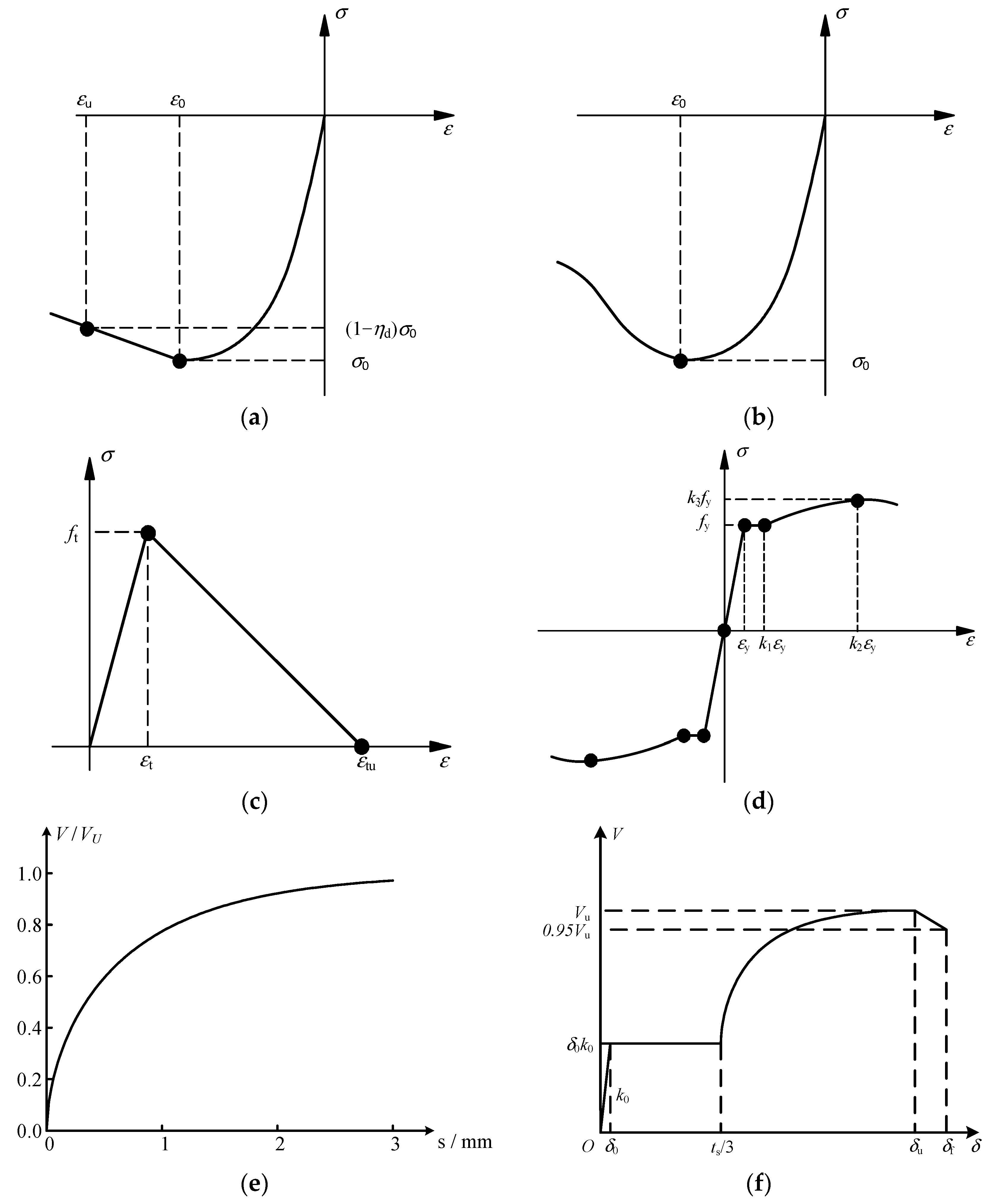

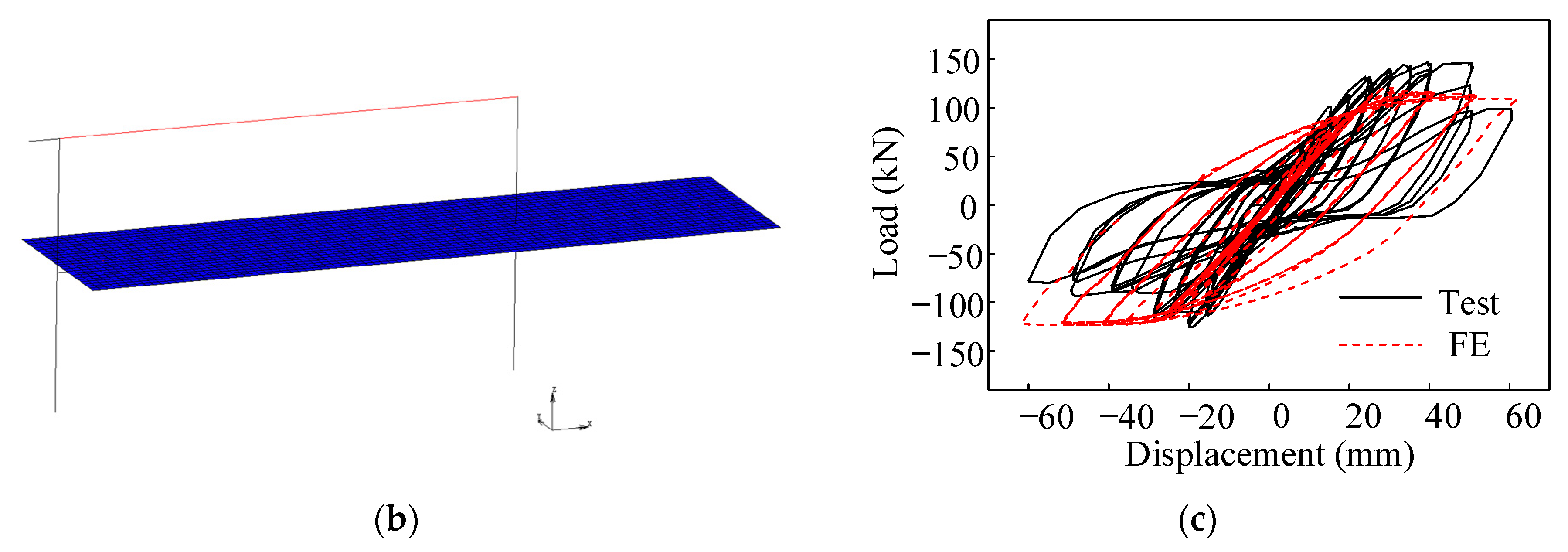
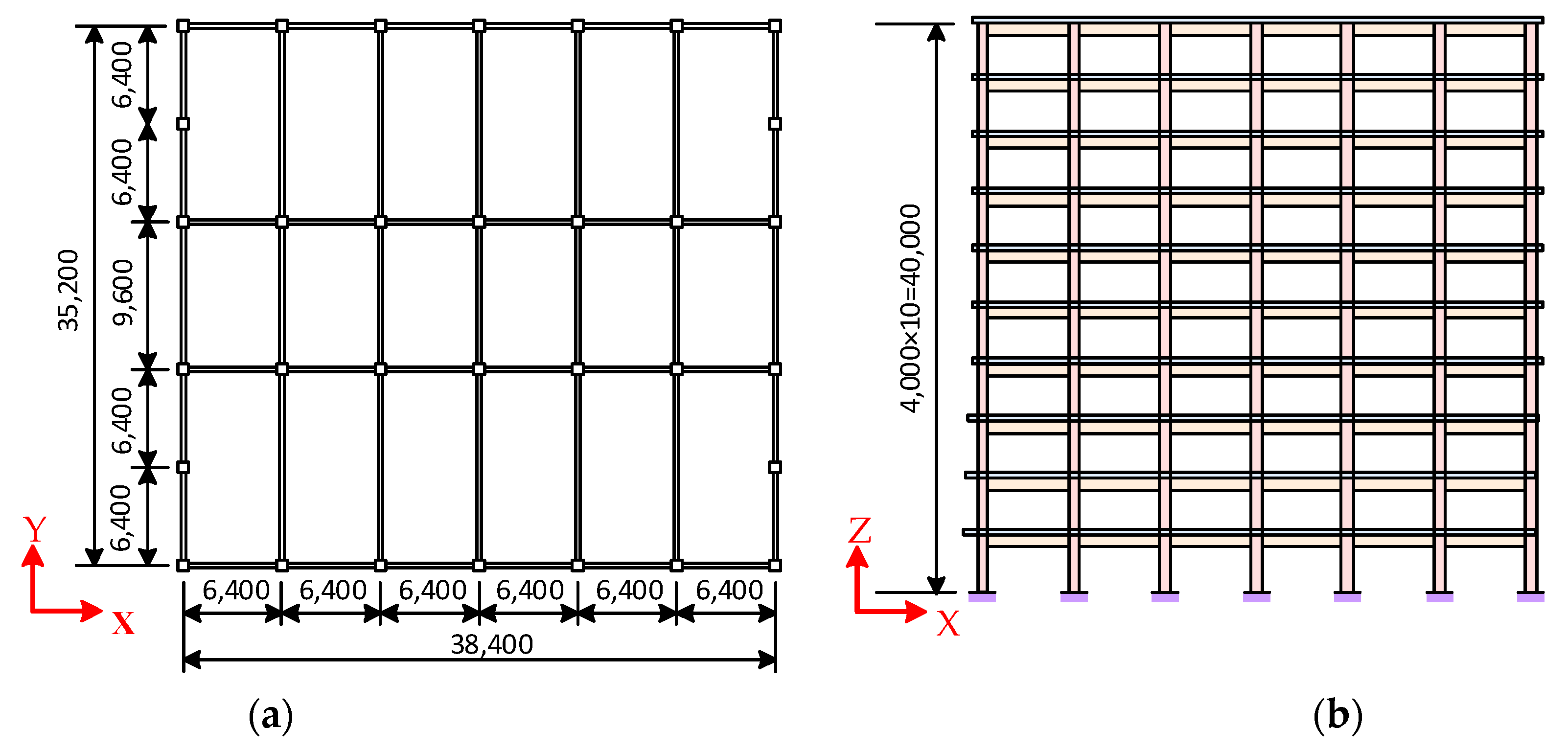
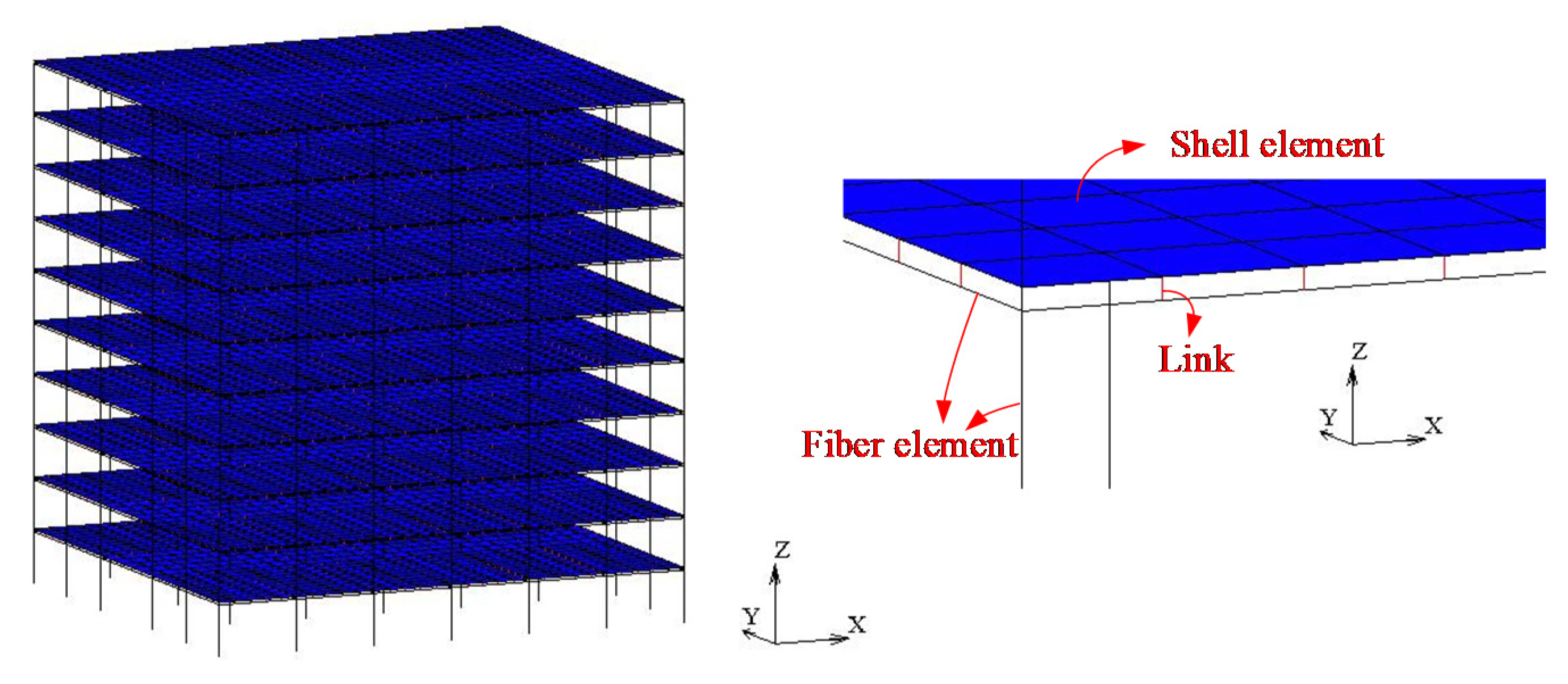
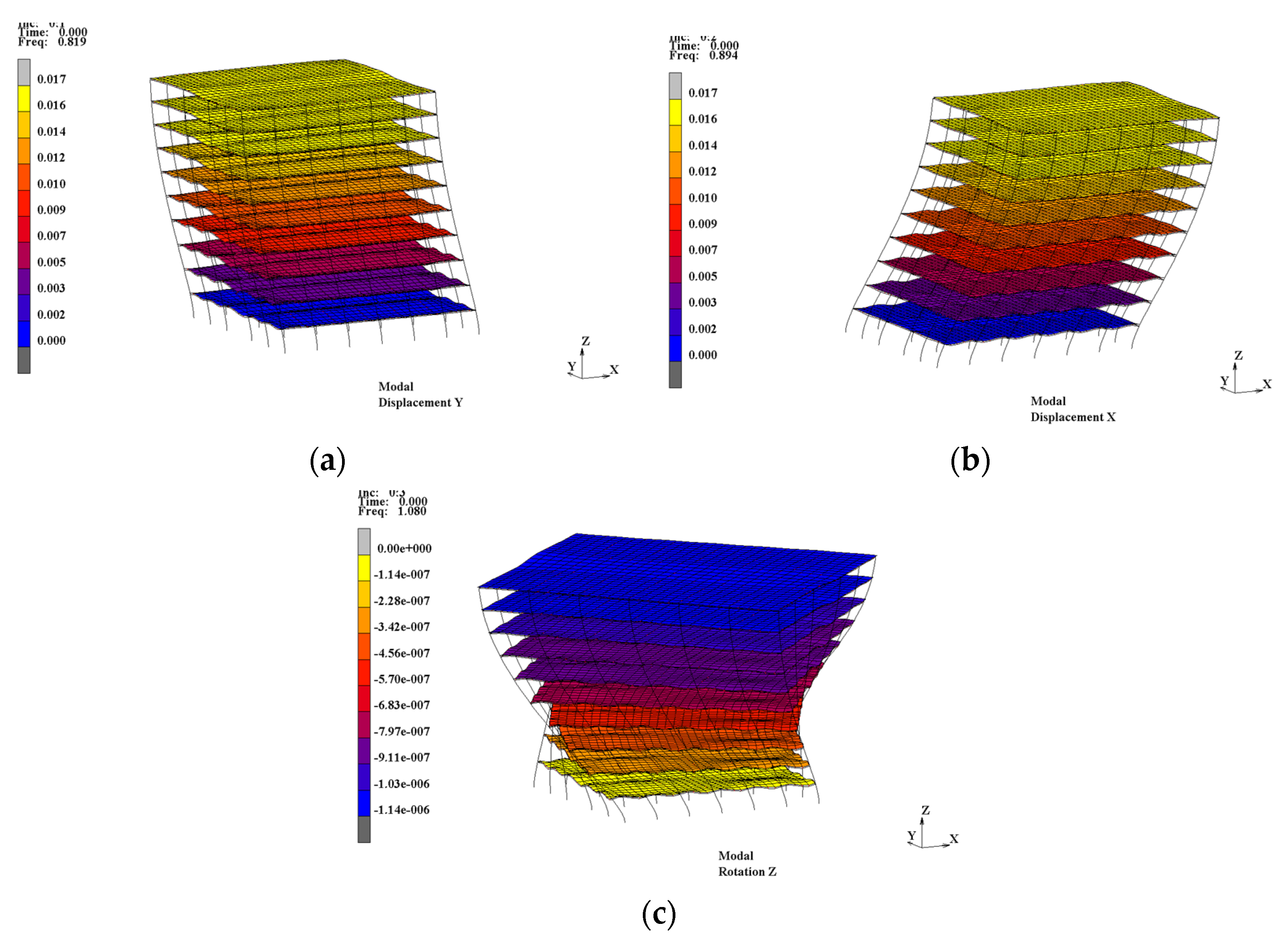
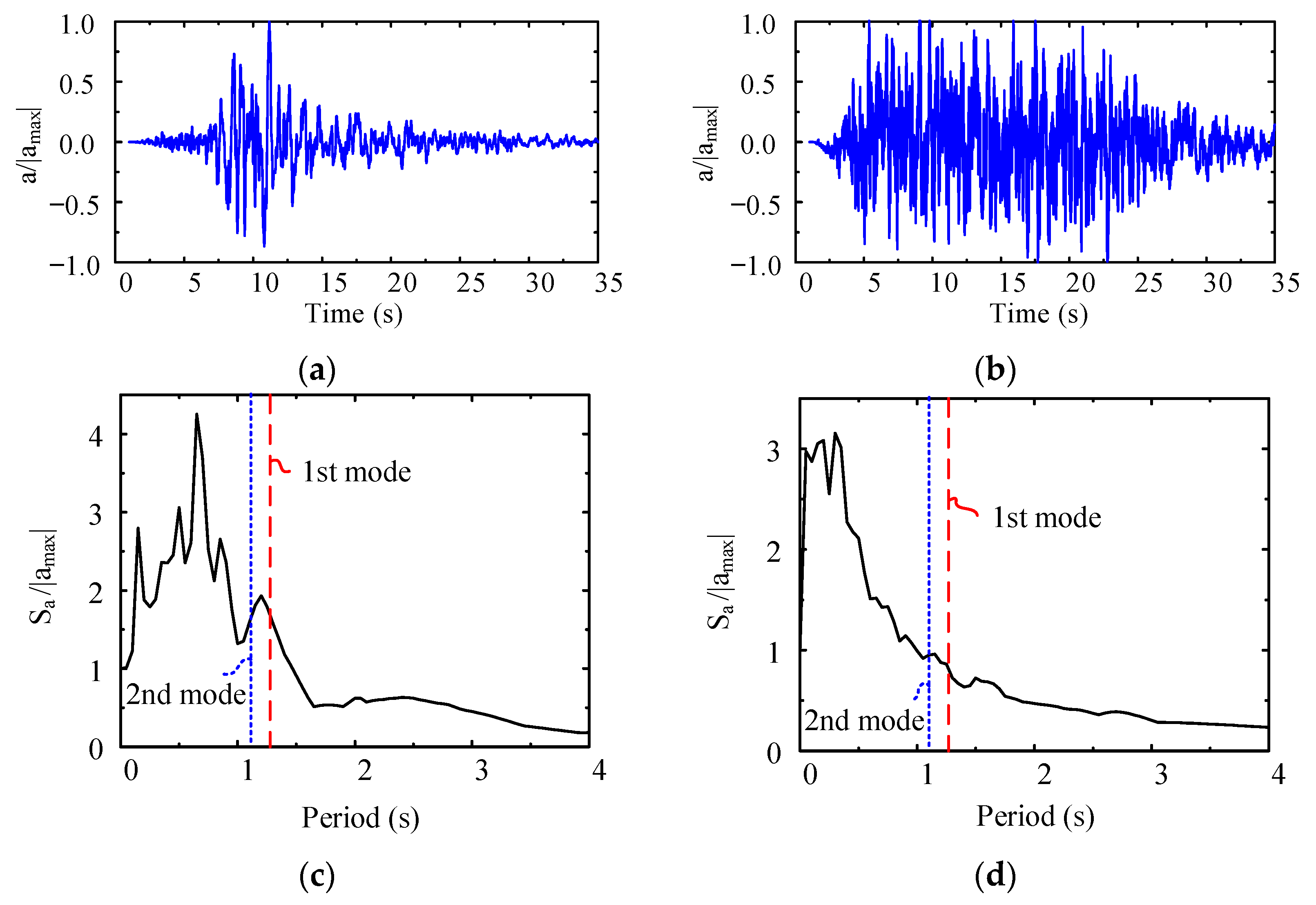





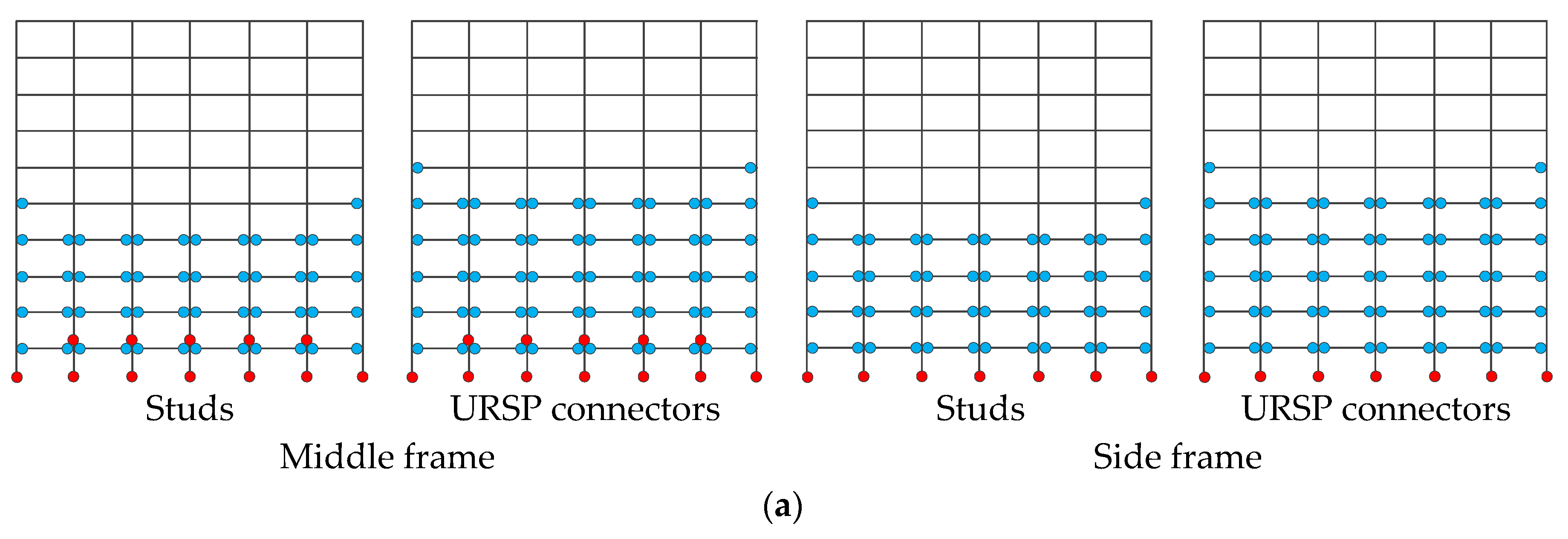
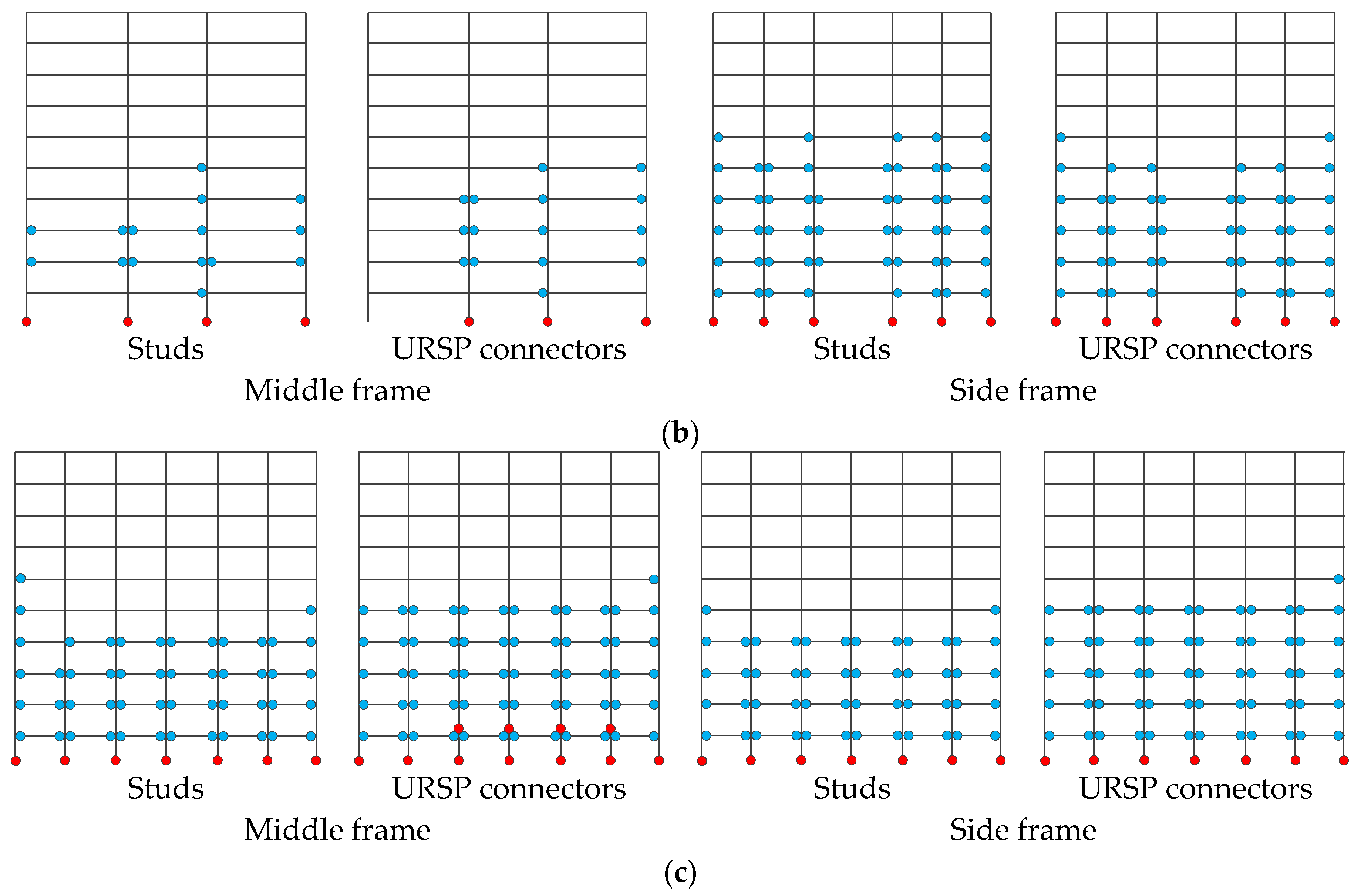

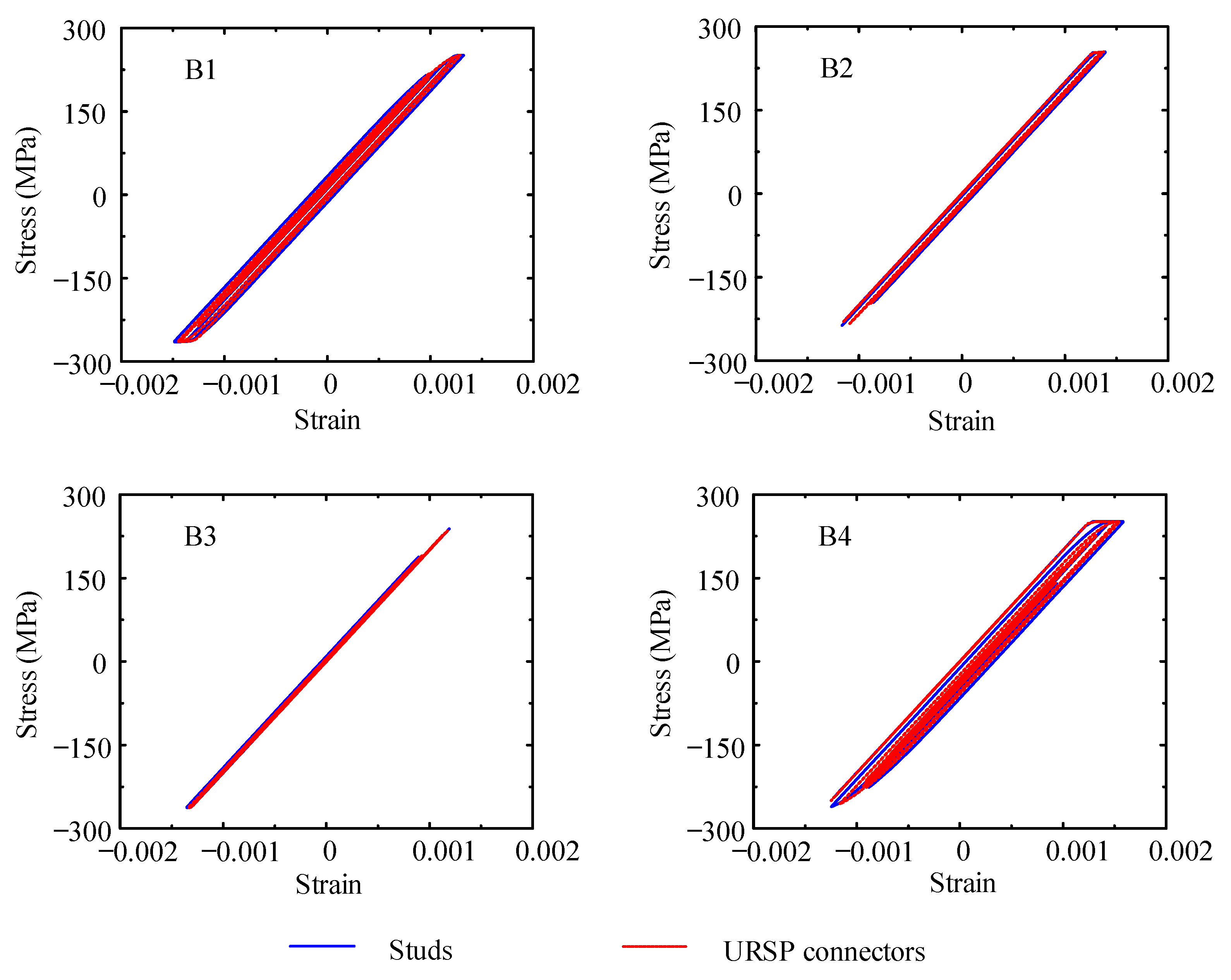
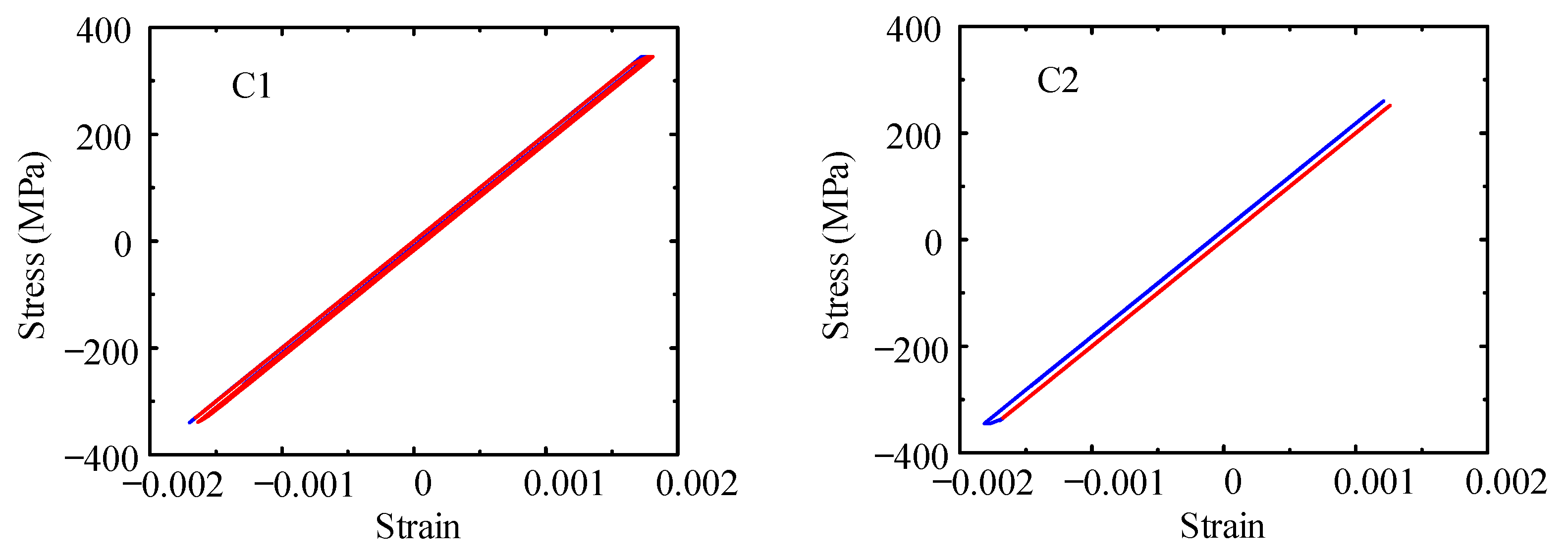

| Mode | Natural Vibration Period (s) | Ratio (Full-Span URSP/Full-Span Stud) | Mode Characteristic | ||||
|---|---|---|---|---|---|---|---|
| Common Nodes | Full-Span Stud | Full-Span URSP | Spring Stiffness = 0 | Steel Beam | |||
| 1 | 1.000 | 1.218 | 1.220 | 1.277 | 1.533 | 1.002 | Y-translation |
| 2 | 0.943 | 1.116 | 1.119 | 1.182 | 1.399 | 1.003 | X-translation |
| 3 | 0.799 | 0.923 | 0.926 | 0.970 | 1.154 | 1.003 | Z-rotation |
| 4 | 0.329 | 0.397 | 0.403 | 0.569 | 0.498 | 1.015 | Y-translation |
| 5 | 0.311 | 0.366 | 0.374 | 0.556 | 0.457 | 1.022 | X-translation |
| 6 | 0.265 | 0.305 | 0.311 | 0.484 | 0.378 | 1.020 | Z-rotation |
| 7 | 0.191 | 0.227 | 0.238 | 0.481 | 0.282 | 1.048 | Y-translation |
| 8 | 0.181 | 0.211 | 0.224 | 0.465 | 0.261 | 1.062 | X-translation |
| 9 | 0.155 | 0.189 | 0.189 | 0.458 | 0.218 | 1.000 | Z-rotation |
| Case XL1 | Case YL1 | Case YS1 | Case XL2 | |
|---|---|---|---|---|
| 1.043 | 1.031 | 1.183 | 1 | 1.128 |
| Floor | Case XL1 | Case YL1 | Case YS1 | Case XL2 | ||||
|---|---|---|---|---|---|---|---|---|
| 10 | 17.9 | 15 | 13.5 | 14 | 3.5 | 2.7 | 14.5 | 12.4 |
| 9 | 24 | 20.5 | 22 | 23.1 | 5.6 | 4.4 | 23.3 | 21.2 |
| 8 | 34.4 | 27.4 | 30.9 | 32.2 | 7.9 | 6.3 | 31.4 | 28.9 |
| 7 | 36.8 | 34.5 | 39.3 | 39.6 | 10.0 | 8.1 | 36.7 | 33.8 |
| 6 | 41.2 | 41.3 | 46.7 | 45.1 | 11.5 | 9.5 | 40.6 | 35.4 |
| 5 | 46.6 | 47.7 | 54.5 | 51.5 | 12.8 | 10.8 | 45.1 | 38.2 |
| 4 | 51.5 | 53.7 | 60.3 | 57.3 | 13.8 | 11.9 | 48 | 44.6 |
| 3 | 54.5 | 55.2 | 61.6 | 60.1 | 14.2 | 12.4 | 51.7 | 48.8 |
| 2 | 49 | 47.6 | 53.3 | 53.3 | 13.2 | 11.6 | 46.3 | 46.1 |
| 1 | 24.1 | 21.4 | 30.7 | 30.1 | 7.9 | 6.7 | 26.8 | 27.5 |
| Floor | Case XL1 | Case YL1 | Case YS1 | Case XL2 | |
|---|---|---|---|---|---|
| 10 | 1.188 | 0.967 | 1.315 | 1.002 | 1.166 |
| 9 | 1.167 | 0.951 | 1.288 | 0.997 | 1.097 |
| 8 | 1.111 | 0.960 | 1.260 | 0.997 | 1.088 |
| 7 | 1.066 | 0.991 | 1.232 | 1.000 | 1.086 |
| 6 | 0.998 | 1.034 | 1.201 | 1.001 | 1.146 |
| 5 | 0.977 | 1.058 | 1.181 | 1.000 | 1.182 |
| 4 | 0.959 | 1.052 | 1.166 | 1.002 | 1.075 |
| 3 | 0.987 | 1.026 | 1.150 | 1.002 | 1.061 |
| 2 | 1.030 | 1.000 | 1.145 | 1.007 | 1.005 |
| 1 | 1.129 | 1.020 | 1.170 | 1.019 | 0.973 |
Publisher’s Note: MDPI stays neutral with regard to jurisdictional claims in published maps and institutional affiliations. |
© 2022 by the authors. Licensee MDPI, Basel, Switzerland. This article is an open access article distributed under the terms and conditions of the Creative Commons Attribution (CC BY) license (https://creativecommons.org/licenses/by/4.0/).
Share and Cite
Duan, L.; Nie, X.; Su, H.; Tan, J. Seismic Response Analysis of Steel–Concrete Composite Frame Structures with URSP Connectors. Materials 2022, 15, 8655. https://doi.org/10.3390/ma15238655
Duan L, Nie X, Su H, Tan J. Seismic Response Analysis of Steel–Concrete Composite Frame Structures with URSP Connectors. Materials. 2022; 15(23):8655. https://doi.org/10.3390/ma15238655
Chicago/Turabian StyleDuan, Linli, Xin Nie, Han Su, and Jike Tan. 2022. "Seismic Response Analysis of Steel–Concrete Composite Frame Structures with URSP Connectors" Materials 15, no. 23: 8655. https://doi.org/10.3390/ma15238655
APA StyleDuan, L., Nie, X., Su, H., & Tan, J. (2022). Seismic Response Analysis of Steel–Concrete Composite Frame Structures with URSP Connectors. Materials, 15(23), 8655. https://doi.org/10.3390/ma15238655












